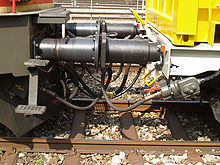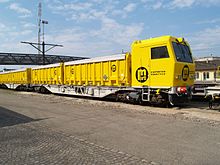Cargo shuttle train
The cargo shuttle train is a commuter train with electric locomotive , container wagons and one from CargoSprinter assumed power car . It has both an electric and a thermal drive ( diesel engine ). In this way, tracks without overhead lines can also be used when shunting , without otherwise having to forego the advantages of the electric locomotive. The cargo shuttle train was developed by Marti Infra AG (contaminated sites, remediation and environmental technology as well as gravel and environmental logistics) together with SBB Cargo and has been in service since April 2009.
conditions
Since some major construction sites in Switzerland deliver building materials by rail via a siding , the cargo shuttle train was developed. It simplifies the transport of materials between loading areas and construction sites.
Zurich main station
The construction site of Zurich main station can hardly be supplied solely by road. In addition, the local conditions did not permit a large excavation pit. That is why the required gravel is delivered by rail in swap bodies.
The tracks at the loading and unloading areas have no overhead lines , as this would make unloading with a crane impossible. In the past, a diesel locomotive had to be available at both transshipment points to maneuver the wagons for loading and unloading work. The pulling power on the route is provided by an electric locomotive. A total of three locomotives are required.
The change of direction is complex of Missed as a commuter locomotive-car compositions, as the traction unit has to be implemented.
development
With the cargo shuttle train, the advantages of the cargo sprinter were combined with the advantages of an electric shuttle train.
The CargoSprinter , developed in 1996, was a pure diesel vehicle with two motorized four-axle container wagons each with a driver's cab and a maximum of three two-axle intermediate wagons . It was ideal for transporting the swap bodies. However, the acceleration was too low until it reached the permitted line speed.
Because of the constant delays in operation, the CargoSprinter's wing train concept did not prove itself . Since additional personnel or a great deal of time was necessary for coupling and disconnecting, the desired flexibility was not achieved. Despite the automatic clutch, a second man is required to re- equip the now connected composition and perform the brake test.
The use of diesel multiple units is ideal for the sidings, but not for line service. This requires a much more powerful diesel unit, which in turn reduces the payload of the driven vehicle . An association made up of several CargoSprinters contains many superfluous driver's cabs, but the engine power of the units in between is necessary for driving on the route. But the train protection equipment in the driver's cabs makes such a vehicle extremely expensive. The susceptibility to errors also increases sharply with many locomotives. In other words, fewer engines are better. The length of the train is less important, as it is often desirable here to keep the load evenly and as required. This saves storage space at the destination ( just-in-time delivery ).
It was decided to build a fixed pendulum composition from an electric motor vehicle and a control car with a thermal auxiliary drive, similar to the CargoSprinter, which can be extended as required with the appropriate adapted intermediate car. Since the multiple control system IIId is most widespread in Switzerland , it was obvious to align the shuttle train to this system, because it enables the locomotive to be replaced without any problems. This lowers fixed costs as no new electric traction vehicle has to be purchased.
One of the CargoSprinters previously sold to Austria was acquired. This was rebuilt. This meant that no new building was necessary for the thermal part of the vehicle.
vehicles
The entire shuttle train is constructed in such a way that intermediate cars that are as unchanged as possible can be used. Therefore, the additional equipment is concentrated on individual cars. Two-section eight-axle container wagons of the type Sggmrrs-z are used as intermediate and coupling wagons. These can accommodate two 25-foot containers per wagon section, i.e. a total of four 25-foot containers (24-foot containers are currently being loaded).
A Re 4/4 II from SBB Cargo will be used as the locomotive in the initial phase . In terms of numbers, it is the most frequent locomotive in Switzerland. Adjustments to the locomotive are not necessary.
When control car and the wagon Marti Infra AG, the wagon keeper. The locomotive remains in the possession of the SBB .
General
The multiple control IIId is quite flexible, as it can be digitized as an up-down control without any problems. This enables relatively light control lines , but requires a converter. It is also possible to adapt two vehicles that are not coordinated with one another. Only both vehicles need to have an up / down control option (standard today). Remote control via the VST IIId only allows remote control of the electric locomotive, not the diesel railcar. This enables a relatively inexpensive converter. However, the diesel railcar has a radio remote control and in this way enables control from the outside. The locomotive driver can thus carry out a push drive with diesel traction on his own. The radio remote control is mainly used in shunting operations. A power supply from the electric locomotive is also advantageous for supplying the control car, as this means that the diesel engine does not have to run in electric mode to supply power to the control car. Because of the converter, the car composition always consists of a coupling car and a control car (currently up to four Sggmrrs-z are permitted). There are two electric cables between the wagons, a ten-wire cable with 3 × 400 V AC and 36 V DC (36 V direct current for multiple control and train protection) and a 14-wire cable for the multiple control. Both cables are loose and are plugged into the corresponding socket on both sides of the car. In addition, a main and a feed line are available as compressed air lines . The train has no UIC or ep line .
Wagon
These are two-part, eight-axle container wagons of type Sggmrrs-z with a permissible payload of a maximum of 144 tons. The wagons were procured by AAE Engineering sro and were manufactured by Lostr as Loundy in the Czech Republic. The car halves are the basic model of a 16-meter-long 50-foot container wagon. A unit consists of two 50-foot units that are tightly coupled with a rod. The flat wagons are designed for an axle load of 22.5 tons and approved for 120 km / h. The wagons can be pushed, which is the basic requirement for a shuttle train.
The second shuttle train for the company Railogistics uses 6-axle container wagons of the type Sgmrss. The AAE is also the wagon keeper for these.
Coupling car
There are currently two coupling wagons that differ from the other wagons only in terms of the additional electrical equipment.
In addition to the converter for the multiple control line, the coupling car also has a converter 1000 volts / 16.7 Hz to 3 × 400 volts 50 Hz. It is the only car that can be coupled to a motor vehicle with multiple control IIId (the control car has no multiple control box IIId). Because of the converter and converter, it has grounding brushes on one axis. Two loose cables are required for coupling, the heating cable and the multiple control cable; these are supplied in the driver's cab of the control car when not in use. The cables are deliberately designed to be pluggable on both sides, since a fixed attachment to the car would lead to damage if it is used without a control car.
Control car
The control car bears the designation STmgmss-t (95 85 2720 901-8) with a permissible payload of a maximum of 38 tonnes, whereby the designation control car used is not entirely appropriate because it has its own drive and would therefore actually be a railcar.
Half of the Cargo Sprinter with a driver's cab and two 25-foot parking spaces serves as the control car. The two 265 kW diesel engines are housed underfloor between the solebars. The inner axles of the bogie are driven (axle sequence (1A) (A1)). The time-time SiFa of the DB, which he already owned as a cargo sprinter, was left as the safety driving circuit. The control car has an ETM balise antenna as well as the train protection magnets for Integra-Signum and ZUB, which are common when it is placed on the market in Switzerland . Since the latter does not offer enough space for the track brakes, it is not allowed to drive on overhangs in the working position, which means that (besides the locomotive) it is the only vehicle in the composition that cannot be freely used (the coupling and intermediate wagons can be used on another train like a normal freight wagon and can also be routed normally). The axle load of the control car is limited to 18 tons and the maximum speed allowed is 120 km / h.
The control car was adapted by Stadler in Winterthur to the Swiss regulations, whereby other technical changes were also made. The engineering of the mechanical and pneumatic conversion was carried out by the Technical Services of ÖBB in Knittelfeld. The conversion of the electrical part was planned and carried out by Tecsol in Anger (A).
commitment
The train can run both electrically and with a diesel engine as a train (the train protection also works in diesel mode). It is common for the diesel engine to drive along the sidings up to a track from where the train can then set off with signals . At the destination station it works in a similar way: The train drives electrically onto a track where the traction type change takes place. Then it travels thermally to its target track.
However, a time of 10 minutes must be allowed for when changing the type of traction. You should also allow at least 15 minutes for turning, i.e. changing the cab.
Since April 2009 Marti AG has been using the first composition to bring gravel-laden 24-foot swap bodies (containers) from Klus and Wangen on the Aare to Zurich main station to the construction site of the Löwenstrasse station . The first mission is carried out with three intermediate cars, so 14 containers can be transported (with a theoretical payload (container and cargo) of 470 tons). If suitable, other relations will be used later. This connection is marketed as the Marti Express Shuttle.
A second composition has been in use since June 2009. This is operated by the company Railogistik and is used between Felsberg-Frauenfeld-Härkingen-Dailliens. This train is loaded with closed swap bodies, on the one hand with parcel post containers and on the other hand with refrigerated containers for the company Heineken, marketed as RailXpress1.
Web links
Website with further pictures of the cargo shuttle train
swell
- ↑ EA 8/2009, p. 415.
literature
- SBB announcement, information sheet Cargo shuttle train CPZ
- Swiss Railway Review 5/2009, pp. 222–227.




